Is there a better measure of something’s value than the smiles it brings? Cargo bikes carry cartloads of smiles for a wide variety of people, as well as smile-value for businesses. Simon Vincett investigates.
Abby started using a wheelchair when she was about four years old. Before then she had specialised strollers. Abby doesn’t walk and never has.
“Abby has a condition called Rett Syndrome, which she was born with,” her mother, Anna, explains. “She can sit unsupported for short periods (a couple of minutes at best) and does not crawl. She was diagnosed at age two after a year of testing. Abby also does not talk, suffers apraxia, epilepsy, scoliosis and relies on us to do everything for her. Just to balance that awful description, Abby is also a very typical six year old girl. She loves Frozen and Tinkerbell, books and silly games, she is stubborn and beautiful, funny and silly. She is loving and is so loved by us.”
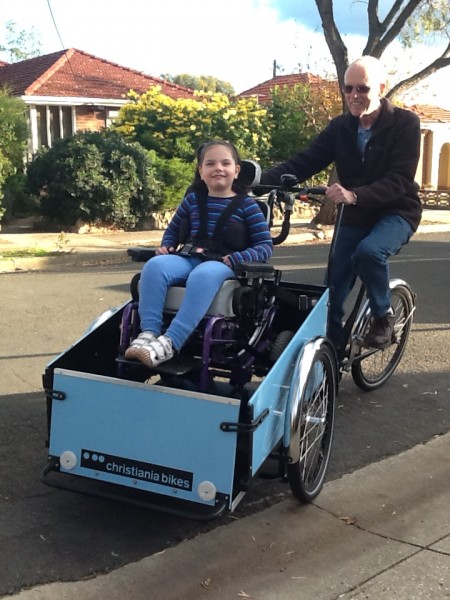 Anna obtained a cargo bike designed to carry Abby in her wheelchair through the National Disability Insurance Agency. The family lives in St Morris, in Adelaide.
Anna obtained a cargo bike designed to carry Abby in her wheelchair through the National Disability Insurance Agency. The family lives in St Morris, in Adelaide.
“Abby loves riding in the bike,” says Anna. “We ride to the park and the school and always get looks when we are riding but they are always nice looks. It is lovely for Abby to be able to do something that all kids get to do and for us to do ‘typical’ family things. Abby has an older brother Sam, who is ten and an older sister Sophie, who is 11. They absolutely adore her.
“The bike means that Abby is included. Inclusion is something that we strive for and as a society need to do better. We try very hard to be as normal as possible as a family and to enjoy things that regular families enjoy. Her Poppy is the best at taking her for rides.
“I would absolutely recommend the bike to families with someone with a disability. Our bike was funded through the NDIA, which was very lucky as it is not something we could have purchased ourselves. Every child should be able to ride a bike and feel the wind in their face and the freedom you feel whizzing down the street.”
It’s not just children with special needs that cargo bikes excel at carrying. Families, individuals, businesses and governments all over the world are finding myriad ways that the versatile cargo bike can serve their purposes, whether it’s carrying their shopping, the dog, street food or light freight. More and more parents are doing the school run in cargo bikes; ice cream sellers and the like are riding to their customers and vending straight from the bike; and governments are looking at inner-urban freight delivery and cargo bikes as a solution to the congestion this creates. It’s the unique offerings of versatility, agility and healthy good fun that make cargo bikes such an excellent option for urban transport.
The term cargo bike encompasses a wide variety of styles of bike developed for different purposes, with the common factor that they can all carry much more than a standard bicycle. Whether two-wheeled or three, with a box in front or a long rack behind, with the addition of an electric motor or not, there are formats of cargo bike for carrying all sorts of cargo up to a weight of around 100kg, depending on the bike.
Cargo bikes are just one alternative to a backpack for carrying your gear on the bike. Our ‘Beyond the backpack’ article lays out other options.
Box trike
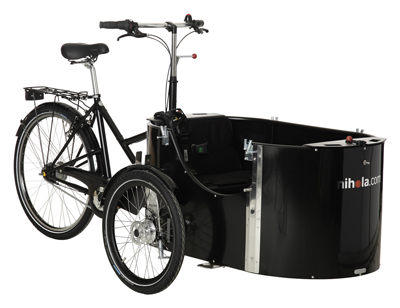
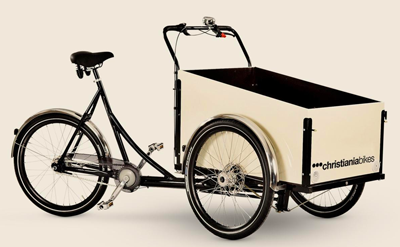
Longtail bike
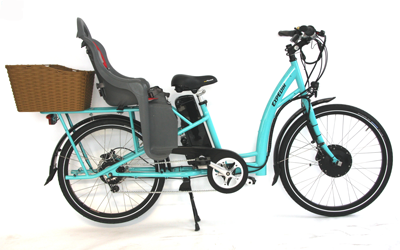
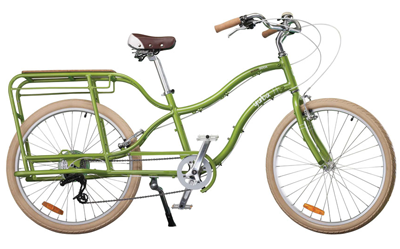
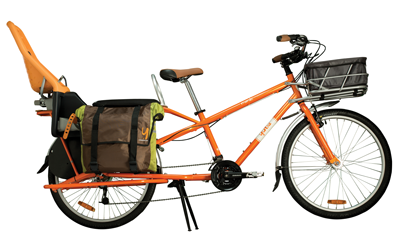
Box bike
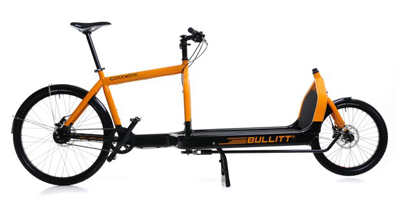
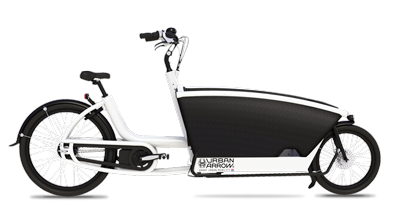
Peter Santos came to cargo bikes to transport his daughter. “I got interested in cargo bikes 23 years ago, when Rosie was little. I was in Denmark so it was a common thing to do. Then I started using cargo bike for everything.”
In the meantime, Santos moved to Melbourne and he brought his Christiania box trike with him. “I started selling them because 11 years ago someone drove into my Christiania that I had brought out here. I wanted to buy a new one and my neighbor said “Maybe I’ll get one too”. So I called Christiania and asked to have them sent out. They offered to send me out three, unassembled, for the same price as two assembled.”
Now Santos operates psbikes, supplying all Australia with Christiania trikes and bikes, and Bullitt cargo bikes. “I was a builder but this was a sign, because the week before I lost all my tools. I got three out. My neighbour never bought one but funnily enough there was a guy in Maria Island in Tasmania who had just been to Denmark, so he bought Christiania number two. Number three I sold to a family who transported their dog. I got four more out and sold them to more people who had been to Denmark.
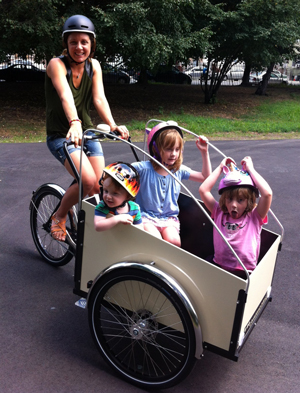 “My big break came in 2008 when ABC used a Christiania in a series they had called Carbon Cops. There was a family in Rose Street, Fitzroy, who had a Land Rover and three small children. Nine out of ten of their trips were under 3km. So the Carbon Cops went in there and told them what they had to do. They had to get low electricity light bulbs, et cetera, but also they had to get this Christiania cargo bike instead of the Land Rover.
“My big break came in 2008 when ABC used a Christiania in a series they had called Carbon Cops. There was a family in Rose Street, Fitzroy, who had a Land Rover and three small children. Nine out of ten of their trips were under 3km. So the Carbon Cops went in there and told them what they had to do. They had to get low electricity light bulbs, et cetera, but also they had to get this Christiania cargo bike instead of the Land Rover.
“They filmed the woman riding around Brunswick Street and for the two-minute film clip the three kids and her were laughing the whole two minutes. When it was shown on television, that night—I had just got a smartphone that made a noise when an email came in—200 emails came through. I replied to them all until the next day.”
Santos has a wealth of experience assisting people to choose the right cargo bike for them, including customisation when necessary. He supplies the wheelchair-ready cargo bike that Abby rides in with her family and he customises boxes for passengers with special needs.
“Over the years I’ve made 15 or so completely special bikes for people and I’ve sold about 40 or 50 of the S-Boxes, which is the box designed to take a wheelchair,” Santos recounts. “The most expensive customised bike I’ve made for a family with an 18-year-old autistic son was $6800 total. To put a ramp in a motor vehicle is $40,000. So we’re not talking about a lot of money in comparison.”
Santos is movingly enthusiastic about this service he provides. It’s obvious he experiences first-hand the difference it makes. “The amount of happiness this child has just by sitting in it is unbelievable. And the amount of freedom the family receives is fantastic. It changes their life—it sincerely changes a family’s life.”
Gary Cookson is the owner of another cargo bike retail business in Melbourne called Cargo Cycles. He also became interested in cargo bikes in order to transport his children. “I’d suffered that carrying kids in trailers and carrying kids in seats on the back of conventional bikes and how that impractical it was to try to get to creche or to kinder. You end up leaning the bike against a fence while you try to get your child out. Cargo bikes seemed to solve that entire problem.”
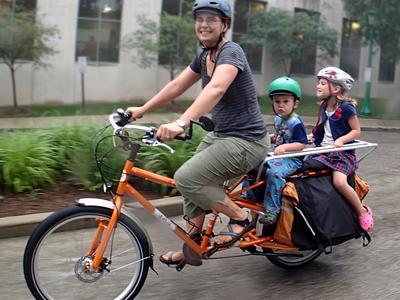
He finds families are the main buyers of his cargo bikes. “The customer base has been fairly consistent: family with a couple of kids somewhere around 5 or 6 years old. They’re families that are trying to do exactly what I was trying to do—they don’t want to drive or it’s impractical to drive, they normally would ride and now they have to factor a couple of kids in. So they’re dropping at schools, dropping at kinders, dropping at creches.”
Cookson now also sells ebikes and electric-motor assisted cargo bikes, which was a logical improvement of the practicality of these bikes. “It got to the point where you could only do so much with cargo bikes and that’s when we introduced electric bikes. The obvious thing to do once you start running out of legs is to add a motor.
“It’s often the situation that dad’s the keen cyclist. Mum’s a cyclist too but not physically strong enough to transport the two kids. They come in and try an electric cargo bike and they can immediately see that the motor will make that 7km commute doable, with kids that just get heavier and heavier. They can see how it will fit into their lives.”
More and more business operators are seeing how cargo bikes fit into their lives too. Peter Santos makes nearly half of his sales of Christiania trikes to businesses for surprisingly varied purposes: “Facepainting, hairdressing, coconuts, beer, beer, bahn mi, icecream, icecream, icecream, Indian food, salads, cold-pressed juices, normal juices, mineral water, dog grooming, mobile mechanics, mobile spray painting, mobile carpenters, gardeners, zoos”.
These bikes are customised by Santos to a greater or lesser degree to suit their purpose. “Businesses buy them for two reasons: firstly for the attention it creates in the beginning and secondly for the sheer economical cost of the whole set-up. I can set-up a cookie stand or a beer bike or anything, for much less than you can do with a van.”
Cargo bikes also offer hassle-free transport. “Businesses in the city use it because it’s easy to get around and the riders don’t need any licence. It’s also easy to store. In smaller places, like Byron Bay, they don’t need to ride far and the regulations are freer—they can ride on the beach and serve their coconuts, for instance.”
The future of freight
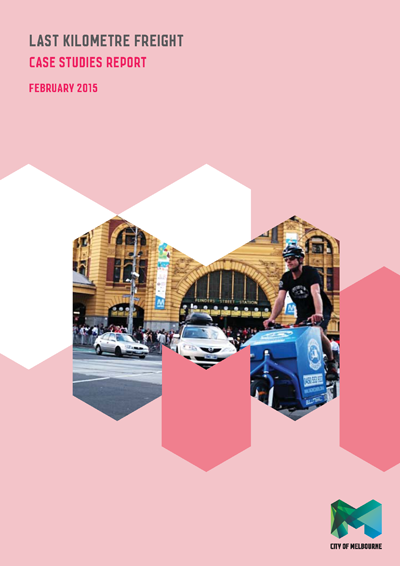 The significant potential of cargo bikes for urban freight delivery has been recognized by the City of Melbourne in their Last Kilometre Freight plan. Councillor Cathy Oke explains, “We average 800,000 people in the city during a weekday and in not that long in will have a million people a day. So we already know that the city is getting busier. We have recently developed a walking plan and it highlighted the economic benefit of walking and people to connect through city blocks to get where they want to be and so we will be improving the walking environment for residents and workers and visitors. Part of that walking plan identified the need to manage how freight gets into the city.”
The significant potential of cargo bikes for urban freight delivery has been recognized by the City of Melbourne in their Last Kilometre Freight plan. Councillor Cathy Oke explains, “We average 800,000 people in the city during a weekday and in not that long in will have a million people a day. So we already know that the city is getting busier. We have recently developed a walking plan and it highlighted the economic benefit of walking and people to connect through city blocks to get where they want to be and so we will be improving the walking environment for residents and workers and visitors. Part of that walking plan identified the need to manage how freight gets into the city.”
“We need to find an approach to that last kilometre that makes it easy for businesses to receive goods as we change our city—as we remove more cars from the city, as we make the streets more pedestrianised. We need to make sure businesses still operate as they expect to.”
The image of the Last Kilometre Freight plan is a picture of Blane Muntz, founder and owner of Melbourne’s only dedicated cargo-bike courier company, Cargone Couriers. He’s a person who well knows the challenges of urban deliveries and the role that cargo bikes can play.
“I was speaking to one van driver for an international company,” Muntz explains, “and he finds it takes up to an hour to do six drops along Collins St by the times he parks and delivers and parks again. And these are only small items. I would expect to take 35 minutes at most. I did 17 drops the other morning inside two hours, originating from North Fitzroy going to West Melbourne, city, Docklands, South Bank, South Wharf. That was 16 from one place and one that fell into my hands along the way. It’s far more efficient.”
Changes to the streetscape need to accommodate an increase in cargo bikes though. “If there were 25 or 30 cargo bikes on the streets every day in Melbourne then most certainly there has to be something in place,” Muntz reasons. “In some of the new buildings the loading bays are quite tight. You wouldn’t want cargo bikes going into that same location.”
Councillor Oke indicates the Last Kilometre Freight plan is thinking along the similar lines. “When we talk about pedestrianising streets, we’re not necessarily talking about closing streets—it’s creating streets for all users. It slows down the traffic environment and we’d want to include in those streets the ability to drop off goods. So that could be a cargo bike parking bay, for instance, or the loading zone might not be a loading zone for a big truck but for cargo bikes or scooters.”
Muntz has a vision for how the system could be improved. “I dream about—and I spoke about it at the Last Kilometre Freight workshop—having consolidation points on the outskirts of the city where fuel based services, the likes of the fruit salad seller Cargone distributes for. It didn’t take him long to realise that his van was taking up to three hours to make six or seven deliveries in the city and copping parking tickets. So he drops them in Richmond now and we pick up any number of boxes and run them into the city.”
“The time in direct transit is probably going to be a little longer than a fuel-based service due to the nature of the roads through there but the time saved once you get to the drop by not having to look for a park and being able to roll straight to the front door is where the advantage comes in.”
Other advantages of cargo bikes identified in the Last Kilometre Freight workshop include the use of cargo bikes to bypass noise restrictions in evening and a cargo-bike share scheme where the bikes are hired by the hour like existing share car systems.
Bicycle Network’s Dean Steinberg, who is contributing to the City of Melbourne’s Last Kilometre Freight plan, explains the significance of the plan for Australian cities: “Space in Melbourne and Sydney’s CBD is hotly contested. As more residents move in and office space opens up the pressure for road space is only increasing. Against this backdrop of congested streets and air filled with the exhaust of idling cars and trucks, the Cities of Melbourne and Sydney are looking for ways to make maintain their high standards of liveability but also protect their economic vitality.”
“The cargo bike will play an integral role in relieving the freight pressures Melbourne’s and Sydney’s CBDs are facing,” Steinberg contests. “Freight consolidation sites on the periphery of CBDs should be identified where larger freight vehicles can off-load their freight and transition it directly onto a cargo bike for immediate dispatch. By allowing exhaust-free and space-efficient cargo bikes to do the last kilometre of deliveries, freight can be delivered quicker, CBDs’ air can be cleaner, transport congestion can be relieved, and road safety for pedestrians and bike riders can improve.”
A spokesperson for the Victorian government Department of Economic Development, Jobs, Transport and Resources, a key partner in the Last Kilometre Freight plan with the City of Melbourne, told Ride On, “The Victorian Government supports the development of strategies for more efficient and low-impact freight deliveries. Bicycle deliveries are currently a small but valuable niche in the city and, along with deliveries on foot, may play an increasingly important role as Melbourne grows.”
However, the department affirms: “The way that freight is delivered will change as the city grows. We are in the great position of being able to plan and prepare for this change so that freight efficiency can be maintained and improved to support local economies, while retaining the amenity that attracts people to Melbourne.”
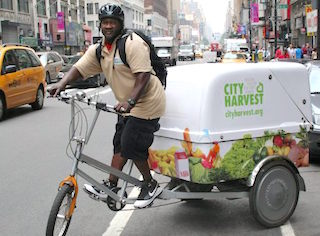 New York State transport researchers have also recently established that cargo bikes offer tremendous advantages for last-mile freight delivery in major cities.
New York State transport researchers have also recently established that cargo bikes offer tremendous advantages for last-mile freight delivery in major cities.
“Cargo cycles offer a tremendous advantage over motor vehicles in parking flexibility; with the ability to park both on- and off-street, cargo cycles can generally be parked much closer to delivery locations and are largely immune to the parking fines that plague New York’s commercial vehicle operators,” according to the report.Results from study indicated that cargo bikes offer a feasible alternative to motorized vehicle operations for local and last-mile deliveries in New York City, even for transportation of temperature-sensitive goods.
European experience has demonstrated that cargo cycles can be successful and even cost-competitive with other modes if a sufficient volume of customers can be identified in a concentrated delivery area, the report concluded.
Freight Tricycle Operations in New York City is a comprehensive, 196 page study of the potential of cargo bikes to help solve the last-mile delivery nightmare that has come with the development of modern, just-in-time logistics.
The delivery of goods in an urban environment presents a tremendous challenge, the report says.
“Traditional motorized vehicles used for goods movement—ranging from cargo vans to box trucks—are inherently incompatible with the multimodal street environments of modern cities, with clean, quiet conditions preferred by residents, and with larger environmental sustainability goals.
“However, in recent years, they have gained traction in both Europe and the U.S. due to the fact that they demonstrate a number of characteristics desirable for operation in modern cities.
“They produce no local emissions, occupy little space for moving and parking, and operate at limited speeds friendly to pedestrians and bicycles.”
The researchers found:
- Cargo cycles may offer faster speeds and more reliable travel times in congested traffic conditions or where regulations limit motor vehicle operations.
- Where regulations allow, cargo cycles can often park closer to a delivery destination—even on the sidewalk directly adjacent to a delivery location.
- Cargo cycles are much smaller than motor vehicles; as a result they consume less road and parking space.
- Human-powered cargo cycles consume no fossil fuels and generate no pollutants from fuel combustion.
- They also produce considerably less noise pollution than motor vehicles.
- Costs for vehicle purchase, parking, maintenance, and vehicle insurance are likely to be much lower for a cargo cycle than for a motorized vehicle.
- While truck drivers face health challenges from idle behavior, cargo cycle operators improve their health through active operation of the vehicle.
- Cargo cycles do not require a specialized license or significant training to operate; as a result, cargo cycle operations provide low-barrier-to-entry jobs in a local community.
The report noted that electric assist had great potential too increase the efficiency of cargo bikes, but that current ebike regulations did not allow for the high power motors required.
Feeling the wind on their face
In Denmark, a country renowned for making good use of bikes, one thoughtful man realised that cargo bikes were the perfect way to take elderly people out for some fresh air and fun.
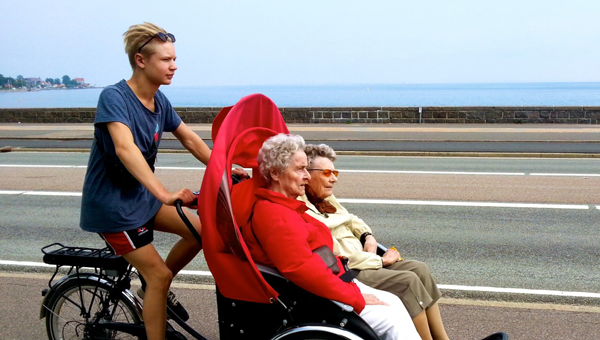
Ole Kassow seized on the rickshaw as the solution to the limited mobility of our ageing elders and hence their limited prospects to enjoy a fresh experience. He started offering free bike rides to the local nursing home residents before partnering with Dorthe Pedersen at the municipality of Copenhagen to buy five rickshaws and launch Cycling Without Age.
“We aim to reach and improve the lives of elderly people making nursing homes a place of joy and continued mobility. We believe that life can and should be beautiful even if you’re close to a hundred years,” explains Kassow.
“We take elderly people out for a bicycle ride—through the city, to the water and the countryside. We break them free from social isolation. Make them smile. Bring back their memories. And let them be part of society again and thereby renew their appetite for life itself.”
The movement has now spread to all corners of Denmark, Norway, and it’s now taking off in several countries around the world. License holders pair volunteer riders with elderly people or nursing homes and provide a rickshaw to make it all possible.
Ride On content is editorially independent, but is supported financially by members of Bicycle Network. If you enjoy our articles and want to support the future publication of high-quality content, please consider helping out by becoming a member.

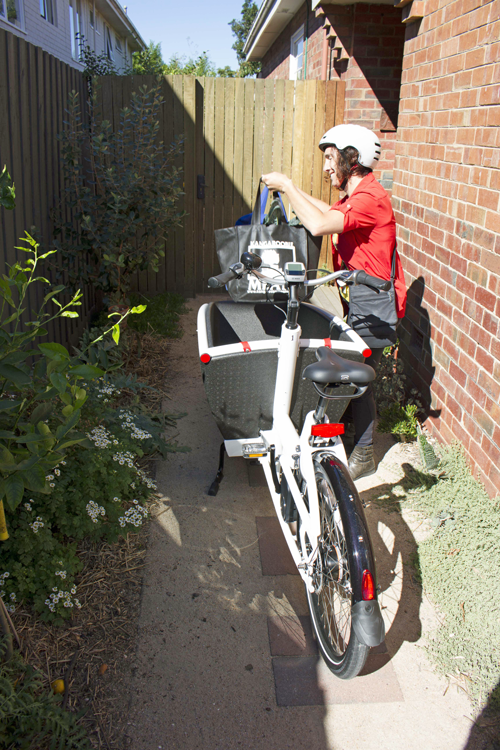
Cargo bikes rule!